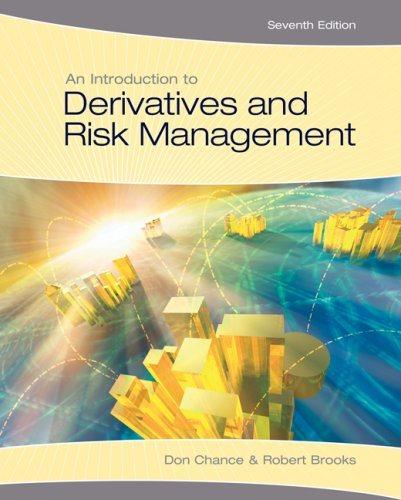Question
1. What is it that a bank wishes to protect from adverse movements in interest rates? 2. What is the goal of hedging in banking?
1. What is it that a bank wishes to protect from adverse movements in interest rates? 2. What is the goal of hedging in banking? 3. What is the concept of gap management? 4. How is a bank's duration gap determined? 5. What are the advantages of using duration as an asset-liability management tool as opposed to interest-sensitive gap analysis? 6. The First National Bank finds that its asset and liability portfolio contain the following distribution of maturities and repricing opportunities: Coming Week Next 30Days Next 31-90Days More Than 90Days Loans Gh200 Gh300 Gh475 Gh525 Securities Gh21 Gh 26 Gh 40 Gh 70 Transaction deposits Gh320 0 0 0 Time Accts Gh100 Gh290 Gh196 Gh100 Money Mkt. Borrowings Gh136 Gh140 Gh100 Gh 65 When and by how much is the bank exposed to interest rate risk? For each maturity or repricing interval, what changes in interest rates will be beneficial and which will be damaging, given the current portfolio position? 7. Find the duration gap and the cumulative gap of the Consolidated Bank of Ghana (CBG), if it has the following entries: Coming Week Gh Next 30 Days Gh Next 31-90 Days Gh More Than 90 Days Gh Interest Revenue 144 110 164 184 Security +29 +19 29 8 Interest Cost 232 --- --- --- Sensitive 98 84 196 35 Liabilities = 36 6 --- --- 8. First National Bank of Barnett currently has the following interest-sensitive assets and liabilities on its balance sheet: Interest-Sensitive Assets Interest-Sensitive Liabilities Federal fund loans Ghs65 Security holdings Ghs42 Interest-bearing deposits Ghs185 Loans and leases Ghs230 Money-market borrowings Ghs78 What is the banks current interest-sensitive gap? Suppose its Federal funds loans carry an interest-rate sensitivity weight of 1.0 while its investments have a rate-sensitivity weight of 1.15 and its loans and leases display a rate-sensitivity weight of 1.35. On the liability side First Nationals rate-sensitivity weight is 0.79 for interest-bearing deposits and 0.98 for its money-market borrowings. Adjusted for these various interest-rate sensitivity weights, what is the banks weighted interest-sensitive gap? Suppose the Federal funds interest rate increases or decreases one percentage point. How will the banks net interest income be affected (a) given its current balance sheet make up and (b) reflecting its weighted balance sheet adjusted for the foregoing rate-sensitivity weights? 9. McGraw Bank and Trust has interest-sensitive assets of Ghs225 million and interest-sensitive liabilities of Ghs168 million. What is the banks cedi interest-sensitive gap? What is McGraws relative interest-sensitive gap? What is the value of its interest-sensitivity ratio? Is the bank asset sensitive or liability sensitive? Under what scenario for market interest rates will the bank experience a gain in net interest income? A loss in net interest income? 10. How can you tell you are fully hedged using duration gap analysis? 12. What are financial futures contracts? Which financial institutions use futures and other derivatives for risk management? 13. How can financial futures help financial service firms deal with interest rate risk? 14. What is a long hedge in financial futures? A short hedge? 15. What futures transactions would most likely be used in a period of rising interest rates? Falling interest rates? 16. Ideal Finance has a portfolio of loans and securities expected to generate cash inflows for the bank as follows: Expected Cash Receipts (Gh) Period in Which Receipts Are Expected 1,385,421 Current year 746,872 Two years from today 341,555 Three years from today 62,482 Four years from today 9,871 Five years from today Deposits and money market borrowings are expected to require the following cash outflows: Expected Cash Payments (Gh) Period in Which Payments Will be Made 1,427,886 Current year 831,454 Two years from today 123,897 Three years from today 1,005 Four years from today ----- Five years from today If the discount rate applicable to the above cash flows is 8 percent, what is the duration of the firm's portfolio of earning assets and of its deposits and money market borrowings? What will happen to the firm's total returns, assuming all other factors are held constant, if interest rates rise? If interest rates fall? Given the size of the duration gap you have calculated, what type of hedging should the firm engage in? Please be specific about the hedging transactions that are needed and their expected effects. Alternative Scenario 1: Given: The discount rate applicable to Ideal's cash inflows and outflows falls to 6 percent. How does the duration of its earning assets and liabilities change? How does this change affect the firm's sensitivity to interest rate movements? Alternative Scenario 2: Given: The appropriate discount rate climbs to 10 percent. What happens to the durations of Ideal's earning assets and liabilities? How does the interest rate sensitivity of Ideal's total return change as a result of this upward movement in the discount rate? 17. A banks cedi weighted asset duration is 6 years. Its total liabilities amount to Gh750 million, while its assets total Gh900 million. What is the cedi-weighted duration of the banks liability portfolio if the banks duration gap were zero? 18. What is the difference between a call option
and a put option? 19. What is an option on a futures contract? 20. What is an Interest Rate Swap?
Step by Step Solution
There are 3 Steps involved in it
Step: 1

Get Instant Access to Expert-Tailored Solutions
See step-by-step solutions with expert insights and AI powered tools for academic success
Step: 2

Step: 3

Ace Your Homework with AI
Get the answers you need in no time with our AI-driven, step-by-step assistance
Get Started


